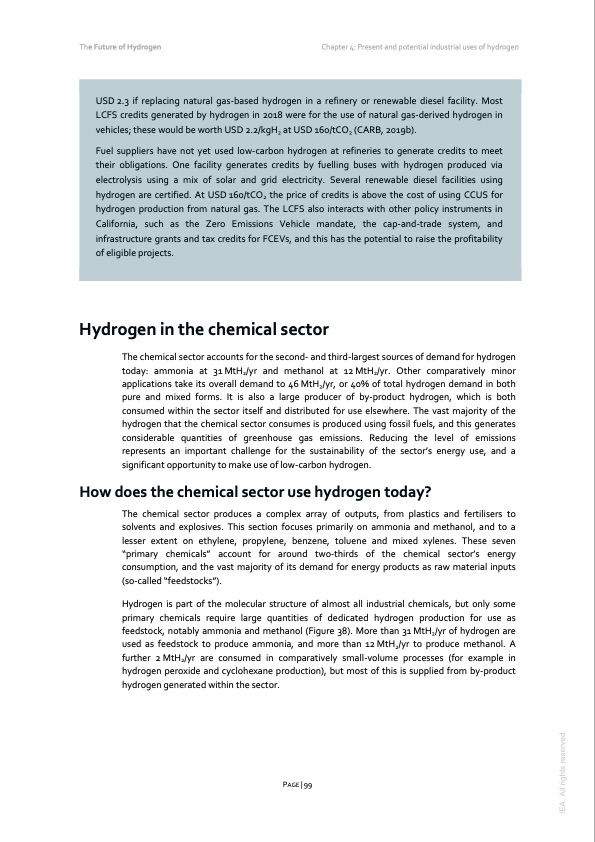
PDF Publication Title:
Text from PDF Page: 099
The Future of Hydrogen Chapter 4: Present and potential industrial uses of hydrogen USD 2.3 if replacing natural gas-based hydrogen in a refinery or renewable diesel facility. Most LCFS credits generated by hydrogen in 2018 were for the use of natural gas-derived hydrogen in vehicles; these would be worth USD 2.2/kgH2 at USD 160/tCO2 (CARB, 2019b). Fuel suppliers have not yet used low-carbon hydrogen at refineries to generate credits to meet their obligations. One facility generates credits by fuelling buses with hydrogen produced via electrolysis using a mix of solar and grid electricity. Several renewable diesel facilities using hydrogen are certified. At USD 160/tCO2 the price of credits is above the cost of using CCUS for hydrogen production from natural gas. The LCFS also interacts with other policy instruments in California, such as the Zero Emissions Vehicle mandate, the cap-and-trade system, and infrastructure grants and tax credits for FCEVs, and this has the potential to raise the profitability of eligible projects. Hydrogen in the chemical sector The chemical sector accounts for the second- and third-largest sources of demand for hydrogen today: ammonia at 31 MtH2/yr and methanol at 12 MtH2/yr. Other comparatively minor applications take its overall demand to 46 MtH2/yr, or 40% of total hydrogen demand in both pure and mixed forms. It is also a large producer of by-product hydrogen, which is both consumed within the sector itself and distributed for use elsewhere. The vast majority of the hydrogen that the chemical sector consumes is produced using fossil fuels, and this generates considerable quantities of greenhouse gas emissions. Reducing the level of emissions represents an important challenge for the sustainability of the sector’s energy use, and a significant opportunity to make use of low-carbon hydrogen. How does the chemical sector use hydrogen today? The chemical sector produces a complex array of outputs, from plastics and fertilisers to solvents and explosives. This section focuses primarily on ammonia and methanol, and to a lesser extent on ethylene, propylene, benzene, toluene and mixed xylenes. These seven “primary chemicals” account for around two-thirds of the chemical sector’s energy consumption, and the vast majority of its demand for energy products as raw material inputs (so-called “feedstocks”). Hydrogen is part of the molecular structure of almost all industrial chemicals, but only some primary chemicals require large quantities of dedicated hydrogen production for use as feedstock, notably ammonia and methanol (Figure 38). More than 31 MtH2/yr of hydrogen are used as feedstock to produce ammonia, and more than 12 MtH2/yr to produce methanol. A further 2 MtH2/yr are consumed in comparatively small-volume processes (for example in hydrogen peroxide and cyclohexane production), but most of this is supplied from by-product hydrogen generated within the sector. PAGE | 99 IEA. All rights reserved.PDF Image | The Future of Hydrogen 2019

PDF Search Title:
The Future of Hydrogen 2019Original File Name Searched:
the_future_of_hydrogen.pdfDIY PDF Search: Google It | Yahoo | Bing
NFT (Non Fungible Token): Buy our tech, design, development or system NFT and become part of our tech NFT network... More Info
IT XR Project Redstone NFT Available for Sale: NFT for high tech turbine design with one part 3D printed counter-rotating energy turbine. Be part of the future with this NFT. Can be bought and sold but only one design NFT exists. Royalties go to the developer (Infinity) to keep enhancing design and applications... More Info
Infinity Turbine IT XR Project Redstone Design: NFT for sale... NFT for high tech turbine design with one part 3D printed counter-rotating energy turbine. Includes all rights to this turbine design, including license for Fluid Handling Block I and II for the turbine assembly and housing. The NFT includes the blueprints (cad/cam), revenue streams, and all future development of the IT XR Project Redstone... More Info
Infinity Turbine ROT Radial Outflow Turbine 24 Design and Worldwide Rights: NFT for sale... NFT for the ROT 24 energy turbine. Be part of the future with this NFT. This design can be bought and sold but only one design NFT exists. You may manufacture the unit, or get the revenues from its sale from Infinity Turbine. Royalties go to the developer (Infinity) to keep enhancing design and applications... More Info
Infinity Supercritical CO2 10 Liter Extractor Design and Worldwide Rights: The Infinity Supercritical 10L CO2 extractor is for botanical oil extraction, which is rich in terpenes and can produce shelf ready full spectrum oil. With over 5 years of development, this industry leader mature extractor machine has been sold since 2015 and is part of many profitable businesses. The process can also be used for electrowinning, e-waste recycling, and lithium battery recycling, gold mining electronic wastes, precious metals. CO2 can also be used in a reverse fuel cell with nafion to make a gas-to-liquids fuel, such as methanol, ethanol and butanol or ethylene. Supercritical CO2 has also been used for treating nafion to make it more effective catalyst. This NFT is for the purchase of worldwide rights which includes the design. More Info
NFT (Non Fungible Token): Buy our tech, design, development or system NFT and become part of our tech NFT network... More Info
Infinity Turbine Products: Special for this month, any plans are $10,000 for complete Cad/Cam blueprints. License is for one build. Try before you buy a production license. May pay by Bitcoin or other Crypto. Products Page... More Info
| CONTACT TEL: 608-238-6001 Email: greg@infinityturbine.com | RSS | AMP |